Home
Camera
Articles FOR SALE
Orders
I Buy / Wants Repairs
Books Adapters
Choosing Accessory Viewfinders
If you have an
interchangeable lens rangefinder or viewfinder camera,
sooner or later you will want to use a lens your camera does not have a built in
viewfinder for. For that, you need an accessory
viewfinder. The problem is that most viewfinders are discontinued and collector's items.
Choosing the best for using (not collecting) takes a bit of experience.
What was a rather hit and miss scenario was made easy with Cosina Voigtlander
currently marketing the largest range of accessory viewfinders ever offered by
any 35mm camera manufacturer.
Whatever you buy, the image
should be clear and bright. Many used finders have fogged up a bit (like their
original owners). Some can be cleaned successfully, and some can't. So
if it needs cleaning, insist upon a bargain price.
12, 15, 21, 25, 28, 35,
40, 50, 75, 90 Voigtlander Viewfinders

Left to Right: Top Row 40, 50 Silver, 50 Black,
75 Black, 75 Silver, 90 Black, 90 Silver -- Bottom Row 12, 15, 21, 25, 28 Metal
Chrome, 28 Plastic, 28 Metal Black, 35 Metal Chrome, 35 Plastic, 35 Metal Black
Generically there are two types of Single
Focal Length finders: BRIGHTLINE finders and NON-BRIGHTLINE finders.
BRIGHTLINE finders have projected framelines -- the earlier finders
have none. Brightlines are a later development and work better, but are more
expensive (what a surprise!).
With a few exceptions, the Leitz brightlines are generally the best single
focal length finders. The earlier metal Leica brightline finders usually cost at least 50%
more than the later, more cheaply made, but better optical image Leica plastic
brightlines. Note that only the outer body casting is metal or plastic, NOT the optics.
Until very recently, we only had choices of long discontinued finders, or
expensive new Leica finders. The many recent vintage Japanese
made screw mounts lenses generally have great finders, at bargain prices.
As this is written in 2003, Cosina Voigtlander offers the largest
lineup of accessory viewfinders ever offered by any camera manufacturer,
they are detailed on a separate page.
- 12 There
is only one choice. In March 2000 Voigtlander (made by Cosina) introduced their
12/5.6 Aspherical Heliar -- with accessory 12 mm brightline finder. This
is the widest production lens ever made for a full frame 35mm camera!
- 15 There
is only one choice. In January 1999 Voigtlander (made by Cosina) their 15/4.5
Aspherical Heliar their new TTL LTM Bessa L -- with accessory 15mm brightline
finder. Well, almost one choice. You can always pop $10,000 for the
Zeiss Hologon made in M mount.
- 16
There is only one choice, the 16mm brightline for the Zeiss Contax G1/G2 Hologon
- 19 This is easy--there's only one choice.
The 19mm Canon Finder. Two slightly different versions. The larger was for the
19mm mirror lock up SLR lens, the smaller for the RF coupled LTM mount 19mm. Either
are very collectible, and expensive.
-
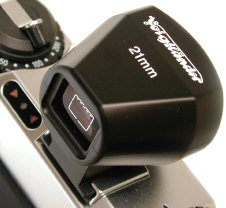 20/21 2001 Voigtlander introduce its new
21/4, with 21 mm Viewfinder. Judging by their other finders, this new 21 finder is
likely to win the "Best Buy" title for 21 finders. Another best buy
is the Russian 20mm black square finder. Excellent optics and low price. I prefer
the black Russian 20 finder to the earlier chrome versions. Also in the best $
to performance category is the Avenon/Kobalux 21 finder. The 21mm Leitz brightline
is great, but expensive if the earlier metal. Choose the cheaper plastic for a user.
You also have the Zeiss Contax 21 finder for the old Contax rangefinder, but I much prefer
the Leica 21 finder. The new 21 finder for the Contax G1/G2 is excellent, but
not as good as the Leica 21. . Watch out for
the Nikon 21 finder made for the Nikon F. Most of the three variations has a
claw type mount which will not fit rangefinder cameras (profile).
The Nikon 21 finder is the worst of the lot anyway. Occasionally you will find a Minolta
21 for their early 21 mirror lock up lens. It's a superb brightline finder.
Yashica's 21 finder for their early 21mm mirror lock up SLR lenses is even better but very
hard to find, quite comparable to Leica's.
20/21 2001 Voigtlander introduce its new
21/4, with 21 mm Viewfinder. Judging by their other finders, this new 21 finder is
likely to win the "Best Buy" title for 21 finders. Another best buy
is the Russian 20mm black square finder. Excellent optics and low price. I prefer
the black Russian 20 finder to the earlier chrome versions. Also in the best $
to performance category is the Avenon/Kobalux 21 finder. The 21mm Leitz brightline
is great, but expensive if the earlier metal. Choose the cheaper plastic for a user.
You also have the Zeiss Contax 21 finder for the old Contax rangefinder, but I much prefer
the Leica 21 finder. The new 21 finder for the Contax G1/G2 is excellent, but
not as good as the Leica 21. . Watch out for
the Nikon 21 finder made for the Nikon F. Most of the three variations has a
claw type mount which will not fit rangefinder cameras (profile).
The Nikon 21 finder is the worst of the lot anyway. Occasionally you will find a Minolta
21 for their early 21 mirror lock up lens. It's a superb brightline finder.
Yashica's 21 finder for their early 21mm mirror lock up SLR lenses is even better but very
hard to find, quite comparable to Leica's.
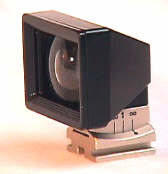
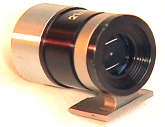
On the left is the Russian 20 finder. Note the mount, it
rocks forward for parallax compensation. On the right is the very hard to find, and
unmarked, Minolta 21 brightline made for Minolta 21/4 SLR mirror lockup lens.
- 24/25 Best as well as the
only current 24 finder is for the new Leitz 24--at least until January 1999
when Voigtlander just introduced a new 25/4 Skopar. The
Voigtlander finder is a cinch to be better than the older Canon and Nikon
finders. The 25 Voigtlander finder for the SC Skopar in Nikon
rangefinder mount is a brightline. The 25 Voigtlander finder for the
25/4 in Leica mount has no brightlines. For 25, the Canon 25 finders are much
better than the smaller and more expensive (more collectible) Nikon 25
finders. The Zeiss 25 finder is virtually unobtainable
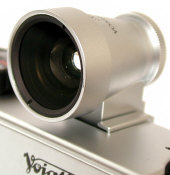
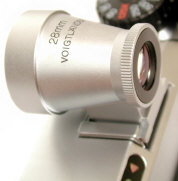
the superb metal Voigtlander 28 brightline
- 28
For years the Leica 28
brightline was the best, but even it was bettered by the metal Voigtlander
brightline introduced in 2003. It is the best 28 finder I have ever
seen. I have not tried the Contax 28 finder for the new Contax G1/G2, but it is
probably comparable with the Leica brightline. The best $ to performance is
the Avenon/Kobalux 28 finder -- but not a brightline. The
Canon is excellent, but not a brightline. The Nikon 28 finder is not that good, and
neither is the Zeiss for the old Contax rangefinder. I also have a superb
black 28 Komura finder (non brightline). It's optical qualities are comparable to
the Leitz, but not its finish, and costs much less.
- 35 Lots of choices here. Again, the brightlines from
Leica, Nikon and Canon are the best. The Leitz 35 brightline was the best of the best and
also the most expensive. 1999 saw the introduction of the superb best buy Cosina
made Voigtlander 35 brightline shown to the right: a best buy.
2003 saw the introduction of the metal Voigtlander 35mm brightline, the best
35 finder I have ever seen.
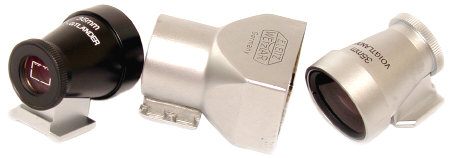
In the center is the classic chrome Leitz 35
brightline, compared to the smaller Voigtlander metal 35 brightline.
The 21, 24, and 28 Leitz brightlines look pretty much the same.
The later black versions kept the same design, just changed the color and
material of the housing from that cheap chrome pictured here to that ultra
expensive and desirable plastic. Note the very large finder area.
These were the best of the wide-angle finders until the new Voigtlander metal
28 and 35 finders were introduced. No parallax compensation.
- 35 Voigtlander Kontur, see 50 Kontur
- 40 Voigtlander, in 2002
Cosina Voigtlander introduced a 40mm brightline for 40/2 Summicron and 40/2
Rokkor owners -- the 1st and only 40 brightline finder !
- 50 Not a lot of choices, but again the
Leitz brightline finder is the best. Canon 50 brightlines can also be found. The Nikon 50
brightline is unbelievably rare and expensive. In late 1999 the superb new Cosina
made Voigtlander 50 brightline was introduced, in either black or chrome, looking very
much like Leica's old 50 brightline: a best buy. A special
limited edition Voigtlander 50 brightline was supplied with the Bessa T 101
Heliar Anniversary sets.
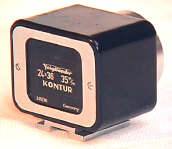
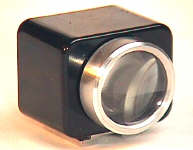 50 Voigtlander Kontur This is a very unusual finder, and
one of my favorites. Made for the Voigtlander Vitessa, the center of the
finder is blacked out! The idea is that you look through it with the right eye, and keep
the left eye open. The finder itself shows the frameline for 50mm, instead of the image! I
know it sounds strange, but our brain puts the images together when one eye sees the image
and the other sees the frameline. This finder will show you virtually unlimited peripheral
vision! It's really too bad other manufacturers did not follow this idea. See it and try
it, you might love it like I do. Note the ""35mm" label on the
finder. This is a bit confusing...it refers to the format, not the lens. This
finder does indeed show a 50 frameline. I am not sure if other focal length
Konturs were made. To confuse things further, those tricky
Voigtlanderians also made a 35mm Kontur. Nevertheless, this is a unique
finder which can do good things for your shooting technique, well worth looking for.
50 Voigtlander Kontur This is a very unusual finder, and
one of my favorites. Made for the Voigtlander Vitessa, the center of the
finder is blacked out! The idea is that you look through it with the right eye, and keep
the left eye open. The finder itself shows the frameline for 50mm, instead of the image! I
know it sounds strange, but our brain puts the images together when one eye sees the image
and the other sees the frameline. This finder will show you virtually unlimited peripheral
vision! It's really too bad other manufacturers did not follow this idea. See it and try
it, you might love it like I do. Note the ""35mm" label on the
finder. This is a bit confusing...it refers to the format, not the lens. This
finder does indeed show a 50 frameline. I am not sure if other focal length
Konturs were made. To confuse things further, those tricky
Voigtlanderians also made a 35mm Kontur. Nevertheless, this is a unique
finder which can do good things for your shooting technique, well worth looking for. -
- 75 The
only easily obtainable 75mm finder is the superb bargain priced Cosina made Voigtlander 75
brightline, just introduced in November 1990. Metal body, glass optics, it
looks like it was modeled after the classic Leitz 50 brightline.
- 85 The best are the Nikon and Canon 85
brightlines.
- 90 The Leitz 90 brightline is great, but
hard to find and expensive. A better choice is probably the new superb Cosina
made Voigtlander 90 brightline introduced in March 2001, black or chrome, looking
very much like Leica's old 90 brightline with dial in parallax correction: a best
buy.
- 105 The best are the
Nikon and Canon brightlines. The Komura is probably excellent as well, but I have
not seen it.
- 135 The best is the Leitz 135 brightline,
followed by the Canon and Nikon brightlines. The Komura is probably excellent as
well, but I have not seen it.
NOTE: Canon made a series of
black finders for their V and VI models which DO NOT work well on other cameras.
You can spot them because they have NO parallax adjustments and they have a
connecting pin in the shoe which adjust the finder for parallax as the camera is focused.
While Canon did made an attachment to use these finders with other cameras, it's so
rare as to be practically unobtainable.
Multi-Finders
Multifinders combine focal
lengths into one finder, either by zooming or with multiple turrets. While
convenient, they do not equal a good a single focal length viewfinder.
Their disadvantages are larger size and weight than single focal length finders.
The 21-24-28 Leica M Zooooom
Finder was introduced in June 2001. It's
rather large, round, and has an estimated street price of $500. This is the
FIRST ever Zoom finder for the M series. It has not proven that popular
with its large size and relatively dim view. Buy the individual
Voigtlander finders instead.
Leica 35-135 Finders for screw mount cameras. Sorry Leitz fans, I think the
competition has you beat on this one. The field of view varies, but the image size is the
same. The earlier ones have the image reversed left to right, very inconvenient.
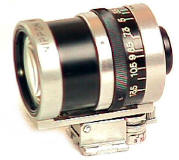 Nikon 35-135 finders. The
chrome ones are called Variframe finders, similar to the Leitz 35-135 finders. They
are hard to find and very collectible. The later Varifocal Nikon finders are superb and of
two types, and my favorite multi-finder. The earlier type has a lever controlled parallax adjustment. The
second type has parallax adjustment dialed in around the rotating eyepiece.
If your Nikon 35-135 finder has a 73 and 90 setting like the one shown,
it was originally intended for a Leica (Nikon made LTM lenses in the 1950's).
Nikon also made an attachment to convert the 35 field to 28. Rare, in
collectible condition, it costs more than the finder!
Nikon 35-135 finders. The
chrome ones are called Variframe finders, similar to the Leitz 35-135 finders. They
are hard to find and very collectible. The later Varifocal Nikon finders are superb and of
two types, and my favorite multi-finder. The earlier type has a lever controlled parallax adjustment. The
second type has parallax adjustment dialed in around the rotating eyepiece.
If your Nikon 35-135 finder has a 73 and 90 setting like the one shown,
it was originally intended for a Leica (Nikon made LTM lenses in the 1950's).
Nikon also made an attachment to convert the 35 field to 28. Rare, in
collectible condition, it costs more than the finder!
Canon 35-135 finders are far and few between, and very collectible. Don't bother, go
with the Nikon version. The Canon short and long zoom finders for the
Canon V/VI series are arguably the best multi-finders EVER. They were
blessed with automatic parallax compensation. A pin in the accessory shoe
changes the view as you focus. Unfortunately, they fit ONLY the Canon V/VI
series -- the best of which in my opinion are the L-1 and the VT-deluxe.
Off brand 35-135 or 35-200 finders are often OK, but often not. Too many kinds to list. Just take a
look and see if the finder is large and clear.
Contax Multi Finders, the best are the post war 25-135 and 21-135 finders. Zeiss took
a different approach. Each focal length has an individual finder, and you rotate to get
what you want. These are excellent finders, but hard to find and expensive. Made for the
Contax, you will have to experiment to successfully use their parallax markings on your
Leica.
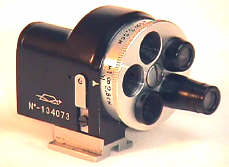 Russian Kiev 28-135 Finder.
Post war, black, a copy of the Zeiss Contax finder. I was surprised to see that despite
the so so finish, the optics give a great image. It has separate turrets for 28, 35,
50, 85, and 135. Just rotate the mounting to the desired focal length.
Parallax compensation is also combined in the rotating frameline mount. A best buy
in the $100 range, but often offered for less. An odd thing about these finders is
that quality control can sometimes give a wider than marked frame on the 28 & 35
framelines. Pictured is the version for the Zorkis and Feds (i.e. Leica mount
cameras) with the optics mounted to the LEFT of the acc shoe. If the optics are
mounted to the RIGHT of the acc shoe, the finder intended for the Kiev / Contax mount
cameras.
Russian Kiev 28-135 Finder.
Post war, black, a copy of the Zeiss Contax finder. I was surprised to see that despite
the so so finish, the optics give a great image. It has separate turrets for 28, 35,
50, 85, and 135. Just rotate the mounting to the desired focal length.
Parallax compensation is also combined in the rotating frameline mount. A best buy
in the $100 range, but often offered for less. An odd thing about these finders is
that quality control can sometimes give a wider than marked frame on the 28 & 35
framelines. Pictured is the version for the Zorkis and Feds (i.e. Leica mount
cameras) with the optics mounted to the LEFT of the acc shoe. If the optics are
mounted to the RIGHT of the acc shoe, the finder intended for the Kiev / Contax mount
cameras.
Komura 35-200 Finder These were sold with the Komura 2x Teleconverter for Leica Screw
mount lenses in the 1980's. It's a nice zoom finder, if you can find one.
There was also a 80-270 Komura finder which is rather mediocre.
Helios 35, 50, 85 finder, modern not so great Japanese finder made for Russian Feds, sold
in UK.
Tewe finders: 35-135,
28-135, 35-200 finder, and probably other focal
lengths too. I'm told of excellent quality, German made. Jem Kime
writes " They made finders not only for themselves but also for other
manufacturers, e.g.. MPP. This was the classic second 'spectacle' eye seen in the famous
Andreas Feininger portrait of the Leica photographer. They made versions which went as
wide as 28mm and as long as 200, the most common variant being 35-135.
Voigtlander Low Angle
Finder
Introduced in March 2000, this finder is
the first of its kind in 35mm Rangefinder history. It allows either low angle
horizontal sighting of super wides, has interchangeable lenses for 15, 21, and 25 lenses,
AND rotates for low level verticals ! While made for the Bessa, it should be
adaptable to practically any 35mm rangefinder camera, even those coming from Germany with
a name starting with L and ending in A !! Once again, Voigtlander has beat Leica at
its own game, introducing an innovative product that Leica should have made decades
ago.
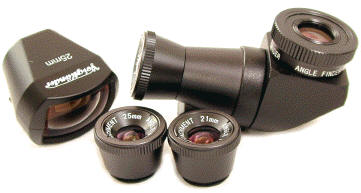
the angle finder with its 15, 21, and 25 attachments, with a 25
finder for size comparison
Cosina's innovation continues to amaze me.
This is a new product, the likes of which no other rangefinder manufacturer has
EVER produced, a waist level finder for low level rangefinder shots, with
attachments for the 15, 21, and 25 lenses. The rear eyepiece has a built in
diopter for clear viewing, and ROTATES for even more versatility. The view is NOT
reversed left to right. It's a VERY bright clear view, without brightline,
with parallax compensation marks. Amazingly, either way you turn the finder to
the right or left, the parallax compensation marks flip to the proper
orientation. More Info
Parallax and Angle of View
Rangefinder viewfinders NEVER have
the accuracy of SLR finders, especially to 100% accurate SLR finder like the Nikon F or
F2. The difference between what you see
in the finder and what you see on the film is generally lumped together and described as
"parallax," though in fact the difference is two problems: parallax AND angle of
view. Before this section makes you paranoid, for most pics, it makes little
practical difference.
Parallax comes from the problem of
having the lens in one place, and the viewfinder in another. The difference in viewing is small, but it does exist. When
focused at infinity, the parallax difference is so small that's it can usually be ignored.
The closer you focus, the more parallax comes into play. If you
have ever taken a pic at 4 feet and cut off someone's head, you have met parallax.
The more sophisticated cameras like the Leica M's, Nikon SP, and Canon 7/7s, and Bessa R
have framelines which move as you focus, thereby providing "parallax
compensation." Less expensive or older cameras either have marked parallax
lines in the camera finder, or even no lines (the photog has go guess). Even
if the older camera has no parallax markings in the finder, you can still have a parallax
corrected view if you mount an auxiliary viewfinder in the accessory shoe that has
parallax adjustments on it. With this system, you focus first, and then adjust the
finder for the focused distance to set the parallax compensation. Generally finders
for 50 and longer lenses have parallax compensation, while wide angle finders do not often
have parallax compensation -- because the problem is usually so small with wider lenses
you don't have to bother with it. The killer problem of parallax is the background.
Even if your camera is absolutely correct on parallax for the focused subject
distance, it's absolutely impossible for a finder to compensate for parallax at other
distances. Suppose your finder shows Uncle Joe just to the left of that telephone
pole behind him. It's possible your lens may be looking at the telephone pole coming
out of Uncle Joe's head....and there is no way knowing it with your rangefinder because
your finder can only compensate for parallax at the FOCUSED distance, not all distances.
If you want as accurate parallax
compensation as possible, do test shots. On your
camera / finder / lens combination, perhaps the 5 foot marking on your finder really
is more like 7 feet, and the 3.5 marking is really more like 5 feet. Unless you test
it out, you won't be sure.
If you are using a finder not made
for your camera, small differences in camera bodies
MAY give you inaccurate parallax adjustments per the markings on the finders. The key word is MAY. Before mixing finders and cameras, test out the new
finder/camera combination for accurate parallax markings BEFORE you use it for important
work. If the parallax adjustments are not accurate AS MARKED, just find out what distances
they are accurate for and go from there. Or if you
are the adventurous type, just let it fly and hope for the best.
THE OTHER PROBLEM is angle of view.
Lenses actually change effective focal length as the
lens is focused from near to far. In other words, your lens actually has
a longer effective focal length focused close than at infinity. Strangely
enough, one of the few rangefinder cameras to compensate for BOTH angle of view and
parallax are the old Polaroid pack cameras, like the 450. NO interchangeable
lens rangefinder (that I am aware of) compensates for both angle of view and parallax.
That's right, the revered Leica M or Nikon SP finders are compromises from the word
go -- with design inaccuracies resulting from the need to keep the size and cost of the
camera down to reasonable levels. Interchangeable lens
rangefinders generally show frame brightlines at their closest focus distance with slides.
This results in infinity shots showing more on your neg than what you saw in
the finder, and close-up shots which have at least what you saw in the finder.
If your finder brightlines were instead optimized for the full
negative at infinity, your near focus negs would not show everything you saw in your
finder -- especially if some of your image is hidden by your slide mount.
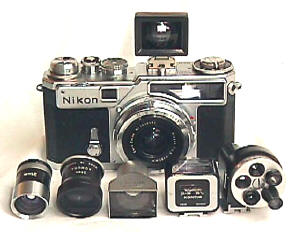
Shown here is a Nikon SP mounting a Contax Zeiss 21 Biogon
lens, with the Russian 20 finder in the accessory shoe. Left to right:
Minolta 21, Komura 28, Leitz 35, Kontur 35, and the Russian Turret finder.
Home
Camera
Articles FOR SALE
Orders
I Buy / Wants Repairs
Books Adapters
Revised:
September 09, 2017
. Copyright � 1998-2003 Stephen
Gandy. All rights reserved. This means you may NOT copy and
re-use the text or the pictures in ANY other internet or printed publication of
ANY kind. Information in this document is subject to change without
notice. Other products and companies referred to herein are trademarks or
registered trademarks of their respective companies or mark holders.

 20/21 2001 Voigtlander introduce its new
21/4, with 21 mm Viewfinder. Judging by their other finders, this new 21 finder is
likely to win the "Best Buy" title for 21 finders. Another best buy
is the Russian 20mm black square finder. Excellent optics and low price. I prefer
the black Russian 20 finder to the earlier chrome versions. Also in the best $
to performance category is the Avenon/Kobalux 21 finder. The 21mm Leitz brightline
is great, but expensive if the earlier metal. Choose the cheaper plastic for a user.
You also have the Zeiss Contax 21 finder for the old Contax rangefinder, but I much prefer
the Leica 21 finder. The new 21 finder for the Contax G1/G2 is excellent, but
not as good as the Leica 21. . Watch out for
the Nikon 21 finder made for the Nikon F. Most of the three variations has a
claw type mount which will not fit rangefinder
20/21 2001 Voigtlander introduce its new
21/4, with 21 mm Viewfinder. Judging by their other finders, this new 21 finder is
likely to win the "Best Buy" title for 21 finders. Another best buy
is the Russian 20mm black square finder. Excellent optics and low price. I prefer
the black Russian 20 finder to the earlier chrome versions. Also in the best $
to performance category is the Avenon/Kobalux 21 finder. The 21mm Leitz brightline
is great, but expensive if the earlier metal. Choose the cheaper plastic for a user.
You also have the Zeiss Contax 21 finder for the old Contax rangefinder, but I much prefer
the Leica 21 finder. The new 21 finder for the Contax G1/G2 is excellent, but
not as good as the Leica 21. . Watch out for
the Nikon 21 finder made for the Nikon F. Most of the three variations has a
claw type mount which will not fit rangefinder 





 50 Voigtlander Kontur This is a very unusual finder, and
one of my favorites. Made for the Voigtlander Vitessa, the center of the
finder is blacked out! The idea is that you look through it with the right eye, and keep
the left eye open. The finder itself shows the frameline for 50mm, instead of the image! I
know it sounds strange, but our brain puts the images together when one eye sees the image
and the other sees the frameline. This finder will show you virtually unlimited peripheral
vision! It's really too bad other manufacturers did not follow this idea. See it and try
it, you might love it like I do. Note the ""35mm" label on the
finder. This is a bit confusing...it refers to the format, not the lens. This
finder does indeed show a 50 frameline. I am not sure if other focal length
Konturs were made. To confuse things further, those tricky
Voigtlanderians also made a 35mm Kontur. Nevertheless, this is a unique
finder which can do good things for your shooting technique, well worth looking for.
50 Voigtlander Kontur This is a very unusual finder, and
one of my favorites. Made for the Voigtlander Vitessa, the center of the
finder is blacked out! The idea is that you look through it with the right eye, and keep
the left eye open. The finder itself shows the frameline for 50mm, instead of the image! I
know it sounds strange, but our brain puts the images together when one eye sees the image
and the other sees the frameline. This finder will show you virtually unlimited peripheral
vision! It's really too bad other manufacturers did not follow this idea. See it and try
it, you might love it like I do. Note the ""35mm" label on the
finder. This is a bit confusing...it refers to the format, not the lens. This
finder does indeed show a 50 frameline. I am not sure if other focal length
Konturs were made. To confuse things further, those tricky
Voigtlanderians also made a 35mm Kontur. Nevertheless, this is a unique
finder which can do good things for your shooting technique, well worth looking for.  Nikon 35-135 finders. The
chrome ones are called Variframe finders, similar to the Leitz 35-135 finders. They
are hard to find and very collectible. The later Varifocal Nikon finders are superb and of
two types, and my favorite multi-finder. The earlier type has a lever controlled parallax adjustment. The
second type has parallax adjustment dialed in around the rotating eyepiece.
If your Nikon 35-135 finder has a 73 and 90 setting like the one shown,
it was originally intended for a Leica (Nikon made LTM lenses in the 1950's).
Nikon also made an attachment to convert the 35 field to 28. Rare, in
collectible condition, it costs more than the finder!
Nikon 35-135 finders. The
chrome ones are called Variframe finders, similar to the Leitz 35-135 finders. They
are hard to find and very collectible. The later Varifocal Nikon finders are superb and of
two types, and my favorite multi-finder. The earlier type has a lever controlled parallax adjustment. The
second type has parallax adjustment dialed in around the rotating eyepiece.
If your Nikon 35-135 finder has a 73 and 90 setting like the one shown,
it was originally intended for a Leica (Nikon made LTM lenses in the 1950's).
Nikon also made an attachment to convert the 35 field to 28. Rare, in
collectible condition, it costs more than the finder!  Russian Kiev 28-135 Finder.
Post war, black, a copy of the Zeiss Contax finder. I was surprised to see that despite
the so so finish, the optics give a great image. It has separate turrets for 28, 35,
50, 85, and 135. Just rotate the mounting to the desired focal length.
Parallax compensation is also combined in the rotating frameline mount. A best buy
in the $100 range, but often offered for less. An odd thing about these finders is
that quality control can sometimes give a wider than marked frame on the 28 & 35
framelines. Pictured is the version for the Zorkis and Feds (i.e. Leica mount
cameras) with the optics mounted to the LEFT of the acc shoe. If the optics are
mounted to the RIGHT of the acc shoe, the finder intended for the Kiev / Contax mount
cameras.
Russian Kiev 28-135 Finder.
Post war, black, a copy of the Zeiss Contax finder. I was surprised to see that despite
the so so finish, the optics give a great image. It has separate turrets for 28, 35,
50, 85, and 135. Just rotate the mounting to the desired focal length.
Parallax compensation is also combined in the rotating frameline mount. A best buy
in the $100 range, but often offered for less. An odd thing about these finders is
that quality control can sometimes give a wider than marked frame on the 28 & 35
framelines. Pictured is the version for the Zorkis and Feds (i.e. Leica mount
cameras) with the optics mounted to the LEFT of the acc shoe. If the optics are
mounted to the RIGHT of the acc shoe, the finder intended for the Kiev / Contax mount
cameras. 
